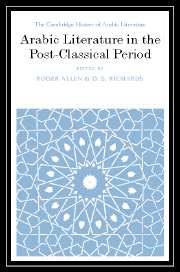Book contents
- Frontmatter
- The post-classical period: parameters and preliminaries
- Part I Elite Poetry
- Part II Elite prose
- Part III Popular poetry
- Part IV Popular prose
- 11 Popular prose in the post-classical period
- 12 A Thousand and One Nights: a history of the text and its reception
- 13 Sīrat‘ Antar ibn Shaddād
- 14 Sīrat Banī Hilāl
- 15 Other sīras and popular narratives
- 16 Popular religious narratives
- Part V Drama
- Part VI Criticism
- Bibliography
- Index
- References
15 - Other sīras and popular narratives
from Part IV - Popular prose
Published online by Cambridge University Press: 28 March 2008
- Frontmatter
- The post-classical period: parameters and preliminaries
- Part I Elite Poetry
- Part II Elite prose
- Part III Popular poetry
- Part IV Popular prose
- 11 Popular prose in the post-classical period
- 12 A Thousand and One Nights: a history of the text and its reception
- 13 Sīrat‘ Antar ibn Shaddād
- 14 Sīrat Banī Hilāl
- 15 Other sīras and popular narratives
- 16 Popular religious narratives
- Part V Drama
- Part VI Criticism
- Bibliography
- Index
- References
Summary
The Arabic tradition of popular literature produced a significant number of sīras other than the well-known Sīrat ‘Antar and Sīrat Banī Hilāl (both of which are discussed in separate contributions to this volume, Chapters 13 and 14). Similar to these two works, the other sīras are works of heroic adventure and romance primarily concerned with depicting the personal prowess, military exploits, innate virtue and incomparable nobility of their heroes. These narratives are pseudo-historical in tone and setting. They base many of their central and secondary characters on actual historical figures, and frame their events within the general context of the historical periods that they presume to represent. Nonetheless, details of history are regularly enhanced by the imaginative improvements of fiction, with the result that history is usually reflected only along general levels of character identity, setting, atmosphere and tone. The importance of this pseudo-historical frame for both composers and audience remains a significant aspect of these works, since it plays an essential role in both their aesthetic and their didactic dimensions. However, at heart these are works of entertainment whose intent is to delight and morally instruct their audiences by presenting larger-than-life deeds and emotions as played out through idealized codes of action.
The written versions of popular sīras tend to be composed in either straight forward prose or, more usually, a style that relies substantially on rhymed prose (saj‘) interspersed with poetry. In general these narratives are exceedingly long, often taking a year or more to narrate fully in oral form. In their longest manuscript and printed versions they run to between two and six thousand pages, depending upon page and script size.
- Type
- Chapter
- Information
- Arabic Literature in the Post-Classical Period , pp. 319 - 329Publisher: Cambridge University PressPrint publication year: 2006
References
- 3
- Cited by



